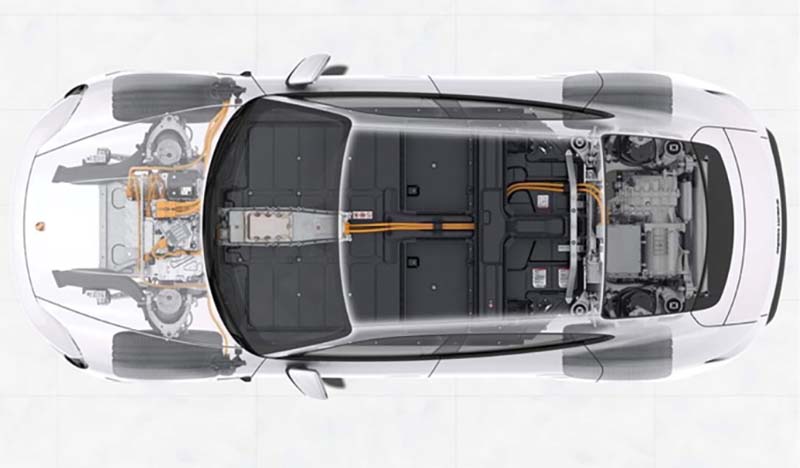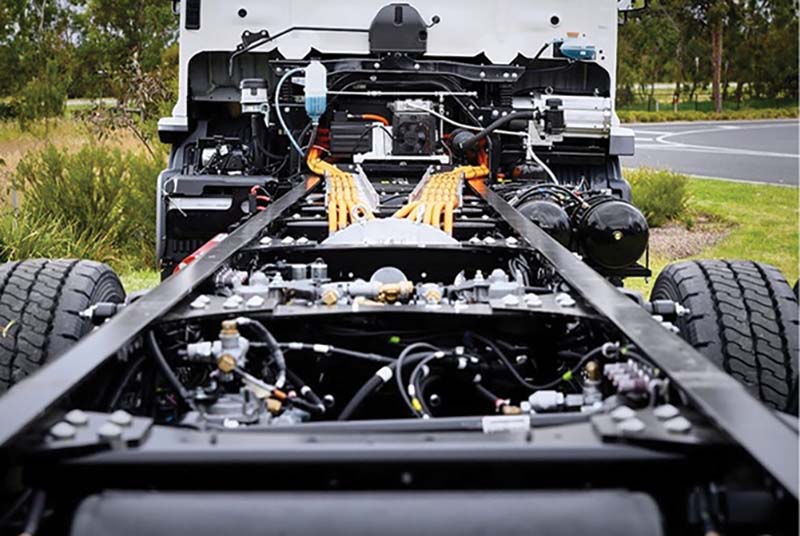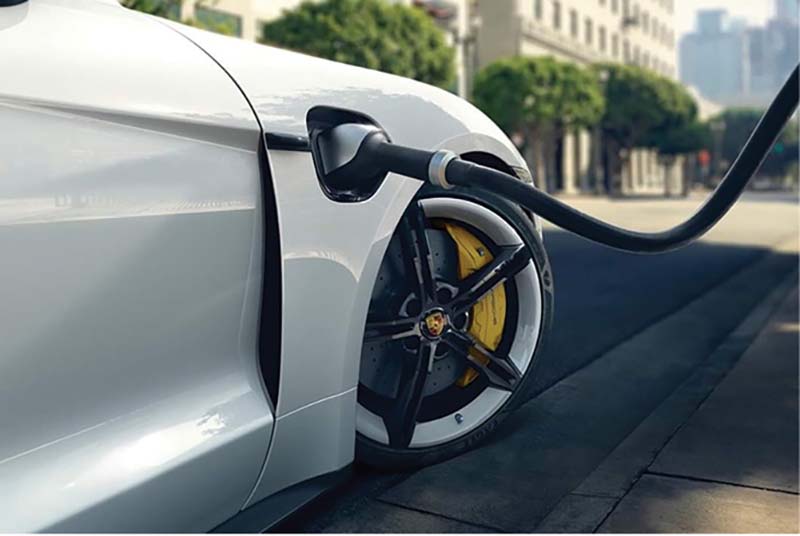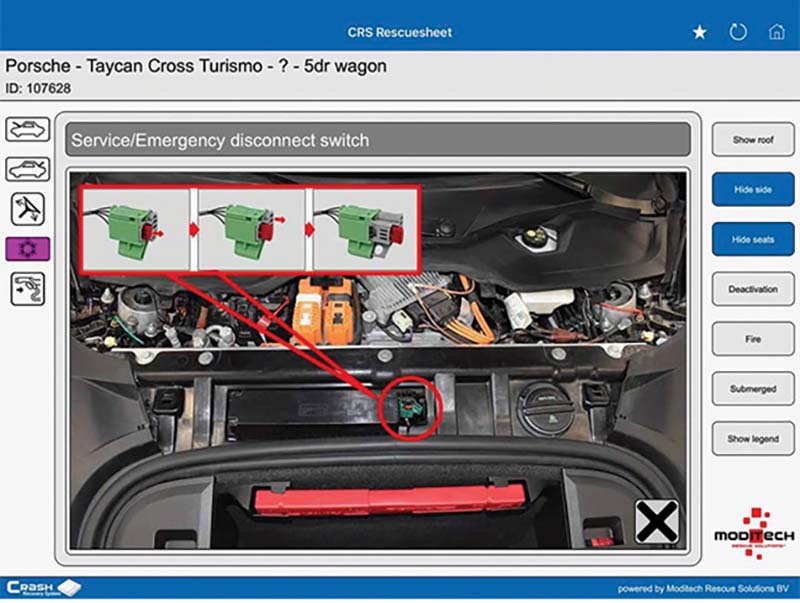Electric vehicle (EV) fires are definitely a hot-button topic in today’s fire service. But why? EVs have been around for 15 years now, and hybrids for 25 years. The technology changes weekly, if not daily. However, rescuers, as end users, are rarely considered. EVs are a different spin on response considerations, especially with fires.
Reimagining Vehicle Rescue and Extrication Methods
Fires involving hybrid vehicles really are not much different than today’s normal internal combustion engine (ICE) vehicles other than having a potentially greater fuel load in the high-voltage (HV) battery pack. Pack sizes are all across the board; some are much less than others on the kilowatt/hour rating of the pack. The state of charge (SOC) will also determine the fuel load. A low SOC means a low fuel load from the pack; a high SOC means a high fuel load from the pack.
That same HV battery pack in an electric vehicle (EV) is the substantial difference between hybrids, EVs, and standard ICE vehicles. What is powering the HV battery pack is key here. Almost all hybrid vehicles use nicad or nickel metal hydride power cells in the HV battery pack. These power cells are very stable thermally during use but, in a fire situation, they will add a significant hazard to the overall fire load of the vehicle. However, because of increased power demand and storage requirements, EVs need a better performance power cell in their HV battery pack.

(1) BMW hybrid vehicle. (Photo courtesy of BMW.)

(2) Porsche Taycan electric vehicle. (Photo courtesy of Porsche.)
This demand currently is met by lithium-based power cells, which are available in a variety of chemical compositions. However, these power cells are not thermally stable under load! The HV battery pack in which they are stored has a cooling system to keep the power cells in a specific thermal range. When one of these lithium-ion power cells goes out of its thermal range, it goes into a state of thermal runaway. Even though it is described as a change in chemical reaction, it is basically a fire in the HV battery pack. This damaged cell may propagate rapidly to surrounding cells, and on and on. In this failed state, the HV battery pack cannot be controlled by its internal cooling system, so responders must cool the HV battery pack externally. There are other ways that a lithium power cell can go into thermal runaway (e.g., being struck; punctured; overcharged; short circuited; heated, submerged, and dried out; or flooded by natural or man-made causes).
We saw these issues on a smaller scale a few years ago with hoverboards. Think of the crazy fire incidents originating with hoverboards; they had only 10 or 12 AA lithium power cells in their battery packs. Imagine the potential fire load of a new Tesla with 400 soup-can- sized lithium power cells in its HV battery pack (definitely talking pears and grapefruits here between EVs and hybrids).
Along with HV battery packs, EVs and hybrids in their construction materials share a significant amount of combustible alloy and composite materials. Even normal ICE vehicles today have both materials in abundance, depending on the vehicle type. However, since combustible alloys and composite materials are lightweight, very strong, and molded/cast into many different ways, they also do not conduct electrical power, an obvious plus in such a vehicle.
Although we will see all sorts of fires from EVs, thermal runaway in the HV battery pack is the type of fire most rescuers focus on in training. Thermal runaway occurs in the lithium-ion power cells of the HV battery pack. We see lithium-ion power cells used in EVs because of the need for greater storage—more outright power for these vehicles’ power needs. Because of their chemistry, some lithium-ion power cells can be thermally unstable and may need a battery management system to keep the cells within a set temperature range and charge state. When one power cell goes out of those ranges or another pathway to go into thermal runaway, that cell is no longer being managed and may begin to take down the cells adjacent to it. At this point, the internal battery pack cooling management has failed and the HV battery pack is in thermal runaway.

(3) An SEA medium duty electric commercial truck. (Photo courtesy of SEA Electric.)
Now, hybrid vehicles do not have this issue because the HV battery pack uses either nicad or nickel metal hydride power cells. Both are thermally stable in use but still present a significant fire load in a fire situation. However, it will not go into thermal runaway like lithium power cells.
Many of the fire load concerns I have discussed so far except the HV battery pack are present in every new vehicle on the street today. Composite materials, plastics, combustible alloys, glazing, and advanced steels and alloys are present in every vehicle today and are hazards and concerns for any extrication and vehicle fire. With alternate fuel vehicles, add in the mixed motive power, which complicates issues on the incident scene.
How do we deal with these vehicles when they burn? After the initial knockdown, we must determine if it is an HV battery fire or a fire caused by something else; that is extremely important. We need to establish what we are dealing with ASAP. We need to obtain the right resources for the right job. Be fully aware such incidents are resource intensive—equipment, people, water, time, and so forth. The key tactic to take home is, “Extinguish the fire and cool the HV battery pack to the ambient temperature.” We have to provide an external cooling system for the HV battery pack since the internal battery management system has failed. If we don’t cool the HV battery pack, we will be returning to this vehicle to fight the same fire some point in the near future—any time from two to 48 hours later.
Don’t use Class A and B foams in such fires; they actually add conductivity to the HV battery pack. Although it might accelerate the fire, the most important part is first rapidly extinguishing the fire and then cooling the battery pack with just water, not foam. However, wetting agents have not been extensively tested on lithium-ion power cell fires. These agents hold much promise as they attack the fire polygon from more than one side, cool the fire, and stop the chemical reaction.

(4) A Tesla vehicle fire at a dealership. [Photo courtesy of the Marietta (GA) Fire Department.]

(5) A Porsche EV charging connection. (Photo courtesy of Porsche.)

(6) A Moditech CRS Porsche Taycan power shutdown screen shot. (Photo by author.)
There are three basic pathways to extinguish and mitigate an electric vehicle fire:
First, simply let the vehicle burn itself out while protecting the exposures. However, be aware that if the fire burns out, reignition may occur if it is a battery pack fire. Remember that, in doing this, it’s a fire that will burn extremely hot, more than 2,800°F, and for some time.
Second, extinguish the fire just like a normal vehicle fire. However, you need to raise the side of the vehicle to allow underneath access to the bottom of the HV battery pack to cool it by flowing only water on it. Check the HV battery pack for hot spots using a thermal imaging camera (TIC) and direct the flow against the hot spots to bring the temperature down to ambient temperature. Depending on the charge state, cooling a battery pack undergoing thermal runaway to ambient temperature will take time and a large amount of water, potentially 3,000 to 8,000 gallons. This does not need to be a continuous flow, but it is better to flow, stop, and check repeatedly until monitoring has determined that the temperature is not going up but is indeed decreasing. Monitor for a minimum of 30 minutes to make sure that temperatures do not rise.
Third, extinguish the fire and then place the vehicle into a container that is then filled with water. This option still fulfills the outside cooling function and replaces the failed internal battery management system, but now we have a vehicle sitting in a container full of water that needs to be mitigated. In North America, there is no easy infrastructure to deal with such an issue. Tesla does not support the dunking of vehicles into a tank of water; this process has resulted in fires, which was not what was expected to happen.
However, in Europe this methodology is popular to use for electric and hybrid vehicles that are involved in a fire or a motor vehicle crash (MVC). The problem is it needs to be carefully problem-solved to confirm that the HV battery pack is the root of the problem. If it isn’t, when the submerged vehicle is dried out, it will go into thermal runaway. So, in addressing fires with alternative-fueled vehicles, in addition to your usual MVC tools, you need a TIC too. It’s a critical tool for the operation.
Fires After MVCs
Often, one issue with EV fires that occur subsequent to high-speed MVCs is that the crash tears open the HV battery pack and lithium power cells are emptied onto the road surface. These power cells will be in a variety of charge states and can be leaking power cell chemicals, although electrolyte leakage is extremely minimal from an individual cell.
Another item to keep in mind is that, in addition to the HV battery pack and the vehicle itself, the fire can involve the wall connector and its infrastructure too, commercial and home systems too. Lockout/tagout is very important for dealing with the charging stations, as most have greater than 110-volt power, even home units. The future looks like portable battery pack chargers, back charging from EV trucks, even back charging your home from EV vehicles. Interesting times are ahead.
Protect Yourself
A critical tool for operating at these incidents is wearing your complete personal protective equipment (PPE) envelope. We already know the dangers from the off-gassing and smoke in a vehicle fire—toxins, carcinogens, acids, and other hazardous materials. Fighting vehicle fires without self-contained breathing apparatus is shortening your lifespan.
Alternative-fueled vehicles add and heighten the respiratory hazards during a fire. The combustible alloys, composite materials, and HV battery pack are the main factors in these additional hazards. Contact with the battery chemistry from the HV battery pack and its power cells postfire can damage our PPE shells, as can the heat.
The topic of EV fires is so dynamic and ever-expanding that it can change almost daily, but the biggest change the fire service has and must embrace is, “Extinguish the fire, then cool the HV battery pack to ambient temperature.”
To stay on top of EV technology when they burn, we need to understand better what we are dealing with. Hybrid vehicles, for the most part, do not use lithium-ion power cells. It will be a huge fire load but can be fought conventionally with more water and preferably wetting agents and foam. The issue is lithium-ion power cells, which will be found in many machines, energy storage units, scooters, and more. So, we have an ever-increasing need for on-scene hazard information, such as Moditech CRS, on your smartphone or tablet today. It’s a critical tool for roadway operations.
Author’s note: Thanks to Mike McConnell of Tesla for his assistance in preparing this article.
DAVID DALRYMPLE has been involved with emergency services for 38 years. He has been teaching first responders vehicle rescue for the past 27 years, educating them on vehicle technology issues and concerns. He is involved with the Society of Automotive Engineers Task Force on electric, hybrid, and alternative-fueled vehicles for first and second responders. Dalrymple is the educator/rescue consultant for RoadwayRescue LLC and has taught at FDIC International since 2003.

